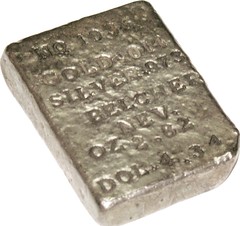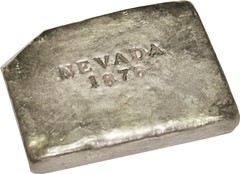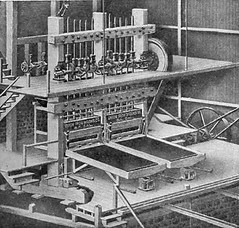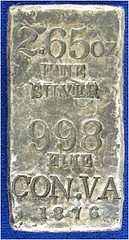
PREV ARTICLE
NEXT ARTICLE
FULL ISSUE
PREV FULL ISSUE
THE NEVADA EXHIBIT AT THE 1876 PHILADELPHIA CENTENNIAL EXHIBITION
Ron Abler submitted this response to Dave Ginsburg's query about the processing of Nevada bullion.
-Editor
I know almost nothing about the overall use of Nevada bullion in the Mints, but I can add some information about some Nevada bullion produced in the Nevada exhibit at the 1876 Centennial Exhibition in Philadelphia. Here is an excerpt from the draft of my book that may be germane:
“In 1873, a select committee of influential businessmen and local politicians recommended to the state government in Carson City that the state of Nevada should consider participating in the great Centennial Exhibition in Philadelphia in 1876. The Comstock Lode in Virginia City had just produced record amounts of silver and gold, and it was a matter of great pride to trumpet the success of the state's mines and good business to expand the market in Nevada silver and gold. “The state legislature appropriated $20,000, the fourth largest appropriation among the states, behind only Pennsylvania, Massachusetts, and New York. The sum was so generous that the committee decided to erect a quartz stamp mill to demonstrate the transformation of Comstock ore into refined silver and gold. To this end, tons of roughly crushed ore were shipped by rail over the three thousand miles to Philadelphia, where exhibition visitors could see for themselves the almost magical process of turning nondescript stone into gold and silver, almost before their very eyes. “Upon entering Machinery Hall, visitors could hear the Nevada exhibit before they ever saw it. Five 775-pound hammers took turns dropping from a height of eight inches ninety-five times every minute, reducing the incoming ore to gravel. The gravel was then carried in a stream of water to the stampers, 120-pound steel dies and shoes that smashed the gravel into a great cast-iron mortar, until it could sift through fine screens as fine as 120 holes per square inch. After settling, the sand slurry was fed into grinders, where the mixture spent three hours turning into putty. Then, mercury was added and a process of amalgamation went on for another four and a half hours. “Once the water was filtered out, the silver-gold-mercury amalgam was heated, splitting out the gaseous mercury for reuse, and concentrating the gold and silver into bullion to be sent to the U.S. Mint, where it was smelted into pure ingots. The silver was used to strike the Nevada silver Centennial medals, and the gold defrayed the expenses of minting the silver and bronze medals. The finished medals were then sold in the California and Nevada Building on the exhibition grounds.


“The Belcher ingot is individually letter punched with “NO. 1036 // GOLD .014 // SILVER .973 // BELCHER // NEV. // OZ 2.82 // DOL. 4.34” The reverse is similarly stamped : NEVADA // 1876. The Consolidated Virginia ingot is cast with the inscription: “2.65 OZ // FINE // SILVER // 998 // FINE // CON.VA // 1876.” The word “silver” was originally cast upside-down, so it was later over-stamped correct side up, which accounts for the apparent doubling at that point.” I have no idea whether these 2000+ ounces of silver appeared in Mint records of Nevada bullion, or whether it represents an amount even worth considering.
To read the earlier E-Sylum article, see:
QUERY: CALIFORNIA REFINERS OF NEVADA BULLION SOUGHT
(www.coinbooks.org/esylum_v13n41a19.html)
The Numismatic Bibliomania Society is a non-profit organization promoting numismatic literature. See our web site at coinbooks.org. To submit items for publication in The E-Sylum, write to the Editor at this address: whomren@gmail.com To subscribe go to: https://my.binhost.com/lists/listinfo/esylum All Rights Reserved. NBS Home Page Contact the NBS webmaster 
|

 “It is probable that some of the output from the mill in the form of bullion ingots was placed on display both at the exhibit in machinery Hall and in the California and Nevada Building, where the medals were sold. None of these original ingots produced at the exhibition are known to have survived, but two ingots produced in Nevada and shipped to the exhibition are known to exist. One was smelted at the Belcher mine and the other with silver from the Consolidated Virginia mine, both of which extract bullion from the Comstock Lode in Virginia City. These are thought to be the only such marked survivors of the Centennial, with the possible exception of uncataloged and, thus, unknown ingots in institutional collections.
“It is probable that some of the output from the mill in the form of bullion ingots was placed on display both at the exhibit in machinery Hall and in the California and Nevada Building, where the medals were sold. None of these original ingots produced at the exhibition are known to have survived, but two ingots produced in Nevada and shipped to the exhibition are known to exist. One was smelted at the Belcher mine and the other with silver from the Consolidated Virginia mine, both of which extract bullion from the Comstock Lode in Virginia City. These are thought to be the only such marked survivors of the Centennial, with the possible exception of uncataloged and, thus, unknown ingots in institutional collections.